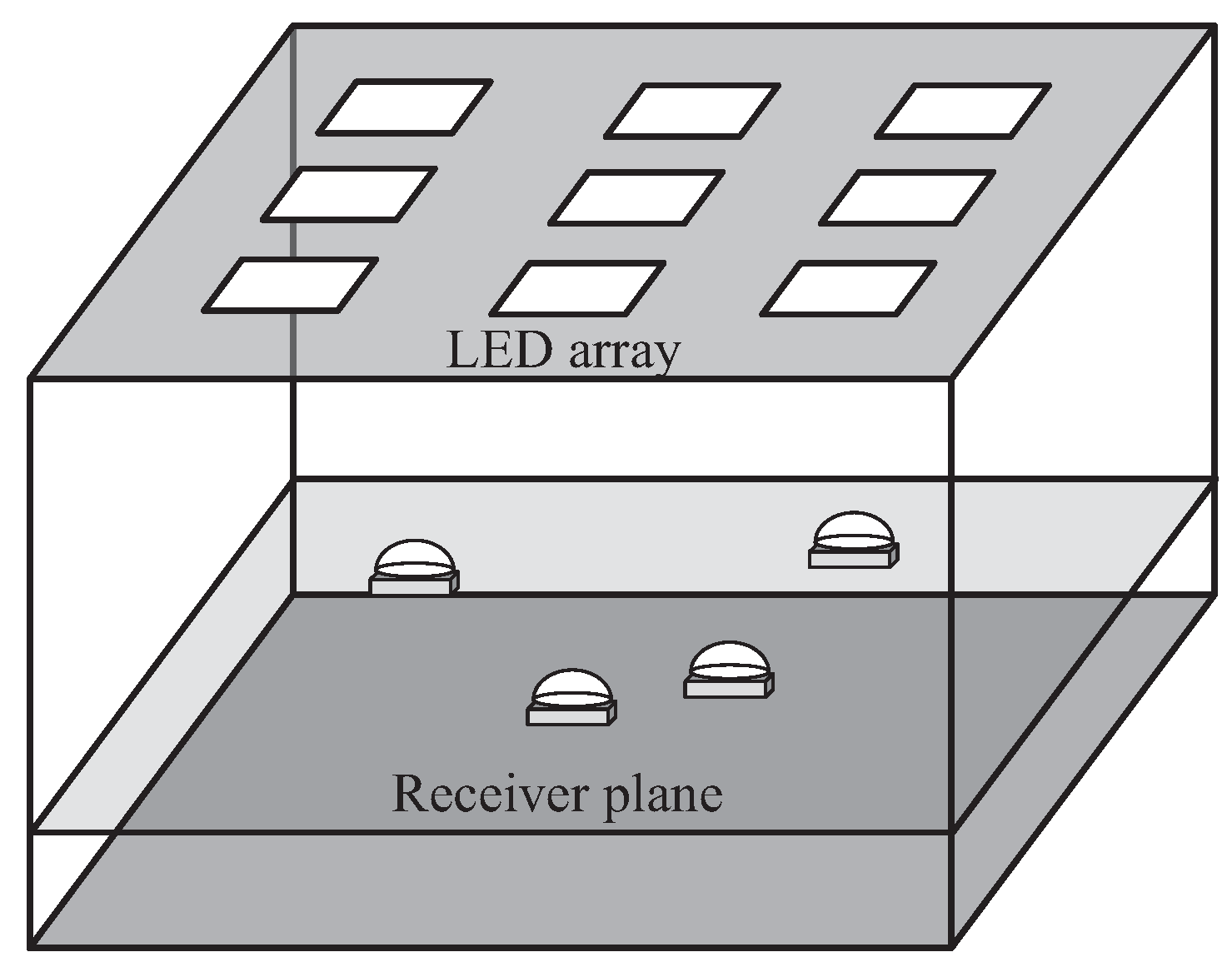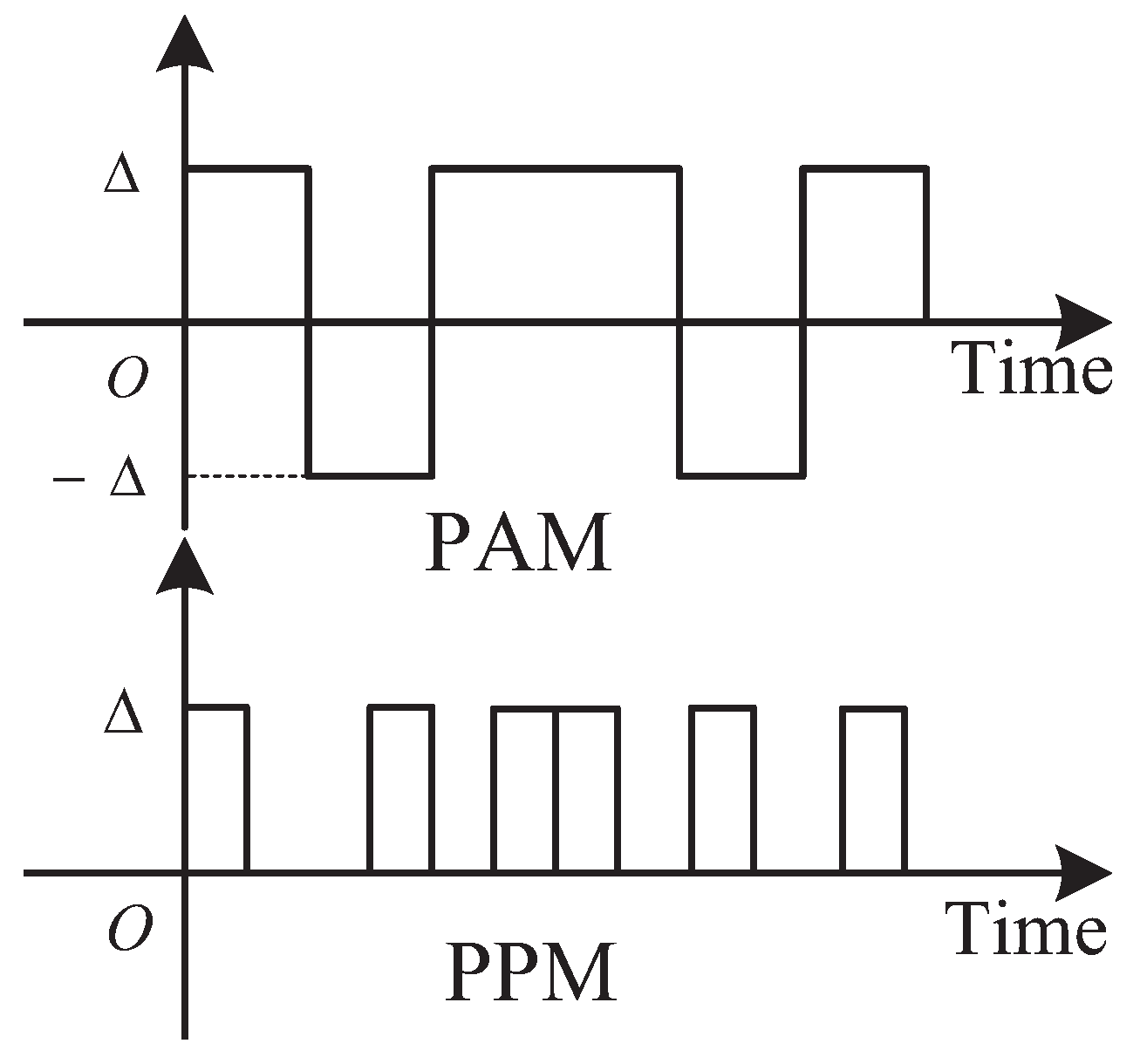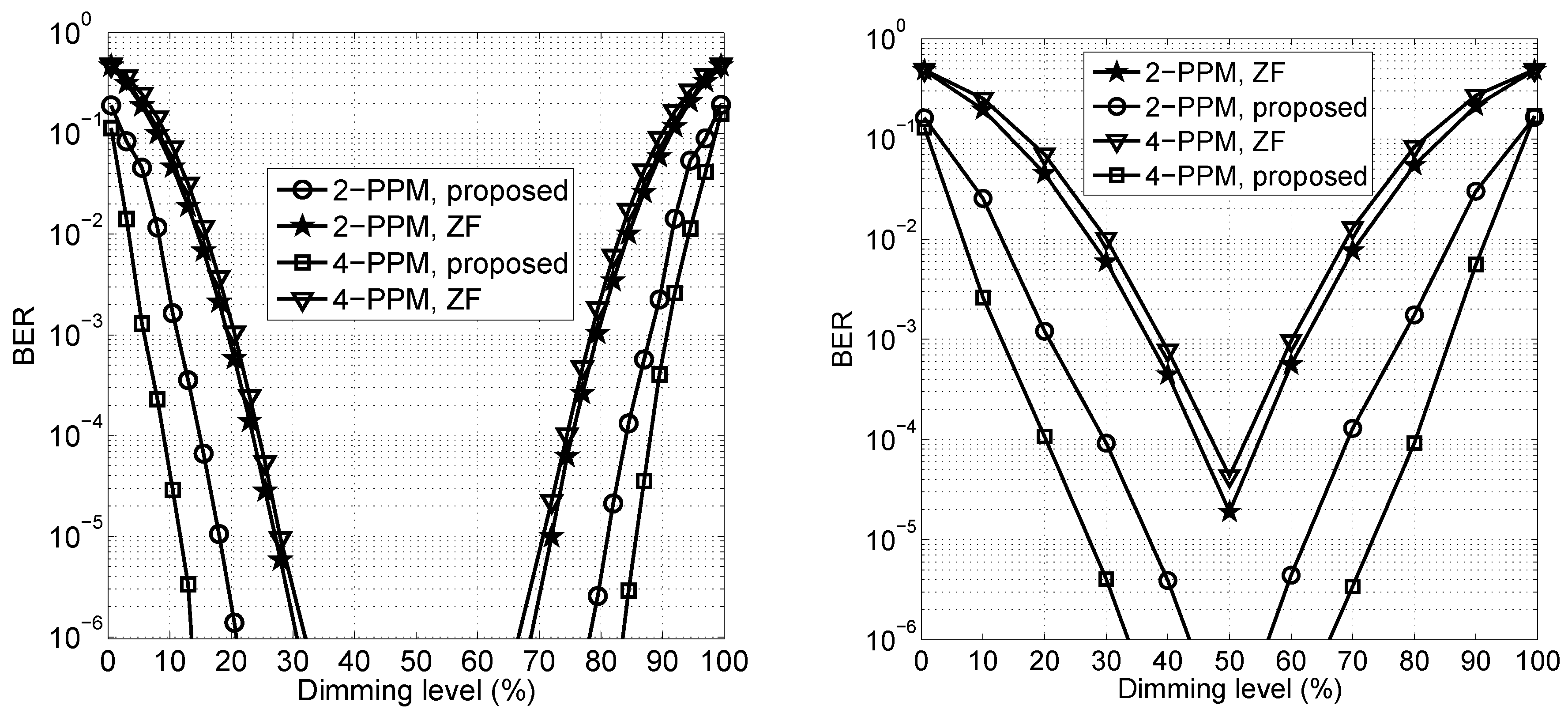Multiuser Transmit Precoding Design for Dimming Compatible Visible Light Communications
Abstract
:1. Introduction
- Instead of being restricted to the special case of zero-mean modulation, our scheme is capable of supporting a wide range of modulation schemes in VLC, such as pulse amplitude modulation (PAM) and PPM with a positive mean.
- In contrast to RF communication, VLC is developed from the LED-based indoor lighting infrastructure. Therefore, several practical optical constraints including the LED non-linearity and illumination requirements are considered in our design for ensuring the normal operation of LEDs, as well as achieving the desired dimming level.
- The optimal TPC subject to these practical constraints are developed with the objective of maximizing the minimum signal-to-interference-plus-noise ratio (SINR) among users. The proposed scheme exhibits a significant performance gain compared to the traditional pseudo-inverse-based ZF TPC.
2. System Model and Optical Power Constraints
2.1. Multiuser VLC Systems
2.2. Optical Constraints
2.3. Dimming Control
3. Joint Multiuser TPC Design and Dimming Control
| Algorithm 1 Joint TPC design and dimming control. |
|
4. Numerical Results and Discussion
5. Conclusions
Author Contributions
Funding
Acknowledgments
Conflicts of Interest
References
- Narukawa, Y.; Ichikawa, M.; Sanga, D.; Sano, M.; Mukai, T. White light emitting diodes with super-high luminous efficacy. J. Phys. D Appl. Phys. 2010, 43, 1–6. [Google Scholar] [CrossRef]
- Chun, H.; Chiang, C.-J.; Monkman, A.; O’Brien, D. A study of illumination and communication using organic light emitting diodes. J. Lightw. Technol. 2013, 31, 3511–3517. [Google Scholar] [CrossRef]
- Komine, T.; Nakagawa, M. Fundamental analysis for visible-light communication system using LED lights. IEEE Trans. Consum. Electron. 2004, 50, 100–107. [Google Scholar] [CrossRef]
- Martínez Ciro, R.A.; López Giraldo, F.E.; Betancur Perez, A.F.; Luna Rivera, M. Characterization of Light-To-Frequency Converter for Visible Light Communication Systems. Electronics 2018, 7, 165. [Google Scholar] [CrossRef]
- Pham, Q.N.; Rachim, V.P.; An, J.; Chung, W.-Y. Ambient light rejection using a novel average voltage tracking in visible light communication system. Appl. Sci. 2017, 7, 670. [Google Scholar] [CrossRef]
- Feng, S.; Li, X.; Zhang, R.; Jiang, M.; Hanzo, L. Hybrid positioning aided amorphous-cell assisted user-centric visible light downlink techniques. IEEE Access 2016, 4, 2705–2713. [Google Scholar] [CrossRef]
- Zuo, Y.; Zhang, J. Energy-efficient optimization design for the multi-color LED based visible light communication systems under illumination constraints. Appl. Sci. 2019, 9, 1. [Google Scholar] [CrossRef]
- Tao, Y.; Liang, X.; Wang, J.; Zhao, C. Scheduling for indoor visible light communication based on graph theory. Opt. Express 2015, 23, 2737–2752. [Google Scholar] [CrossRef] [PubMed]
- Yin, L.; Haas, H. Physical-layer security in multiuser visible light communication networks. IEEE J. Sel. Areas Commun. 2018, 36, 162–174. [Google Scholar] [CrossRef]
- Hong, Y.; Chen, J.; Wang, Z.; Yu, C. Performance of a precoding MIMO system for decentralized multiuser indoor visible light communications. IEEE Photonics J. 2013, 5, 1–12. [Google Scholar] [CrossRef]
- Huang, M.; Guan, W.; Fan, Z.; Chen, Z.; Li, J.; Chen, B. Improved target signal source tracking and extraction method based on outdoor visible light communication using a cam-shift algorithm and kalman filter. Sensors 2018, 18, 4173. [Google Scholar] [CrossRef] [PubMed]
- Zafar, F.; Karunatilaka, D.; Parthiban, R. Dimming schemes for visible light communication: The state of research. IEEE Wirel. Commun. 2015, 22, 29–35. [Google Scholar] [CrossRef]
- Wang, Z.; Zhong, W.D.; Yu, C.; Chen, J.; Francois, C.P.S.; Chen, W. Performance of dimming control scheme in visible light communication system. Opt. Exp. 2012, 20, 18861–18868. [Google Scholar] [CrossRef]
- Wang, J.-B.; Hu, Q.-S.; Wang, J.; Chen, M.; Wang, J.-Y. Tight bounds on channel capacity for dimmable visible light communications. J. Lightw. Technol. 2013, 31, 3771–3779. [Google Scholar] [CrossRef]
- Yu, Z.; Baxley, R.; Zhou, G. Multi-user MISO broadcasting for indoor visible light communication. Proc. ICASSP 2013, 20, 4849–4853. [Google Scholar]
- Shen, H.; Deng, Y.; Xu, W.; Zhao, C. Rate-maximized zero-forcing beamforming for VLC multiuser MISO downlinks. IEEE Photonics J. 2016, 8, 1–13. [Google Scholar] [CrossRef]
- Zhao, Q.; Fan, Y.; Deng, L.; Kang, B. Rate-maximized zero-forcing beamforming for VLC multiuser MISO downlinks. Opt. Commun. 2017, 384, 101–106. [Google Scholar] [CrossRef]
- Li, B.; Wang, J.; Zhang, R.; Shen, H.; Zhao, C.; Hanzo, L. Multiuser MISO transceiver design for indoor downlink visible light communication under per-LED optical power constraints. IEEE Photonics J. 2015, 7, 1–15. [Google Scholar] [CrossRef]
- Ma, H.; Lampe, L.; Hranilovic, S. Coordinated broadcasting for multiuser indoor visible light communication systems. IEEE Trans. Commun. 2015, 63, 3313–3324. [Google Scholar] [CrossRef]
- Shen, H.; Deng, Y.; Xu, W.; Zhao, C. Rate maximization for downlink multiuser visible light communications. IEEE Access 2016, 4, 6567–6573. [Google Scholar] [CrossRef]
- Chen, J.; Wang, Q.; Wang, Z. Leakage-based precoding for mu-MIMO VLC systems under optical power constraint. Opt. Commun. 2017, 382, 348–353. [Google Scholar] [CrossRef]
- Wang, Q.; Wang, Z.; Dai, L. Asymmetrical hybrid optical OFDM for visible light communications with dimming control. IEEE Photonics Technol. Lett. 2015, 27, 974–977. [Google Scholar] [CrossRef]
- Boyd, S.; Vandenberghe, L. Convex Optimization; Stanford University: Stanford, CA, USA, 2004. [Google Scholar]
- Wiesel, A.; Eldar, Y.; Shamai, S. Zero-forcing precoding and generalized inverses. IEEE Trans. Signal Process. 2008, 56, 4409–4418. [Google Scholar] [CrossRef]
- Arnon, S.; Barry, J.; Karagiannidis, G.; Schober, R.; Uysal, M. Advanced Optical Wireless Communication Systems; Springer International Publishing: Cham, Switzerland, 2012. [Google Scholar]





| Parameter | Value |
|---|---|
| Number of LED arrays | 9 |
| Number of LEDs per array | |
| LED pitch | |
| Size of LED array | |
| Transmitter semi-angle | |
| Receiver FOV | |
| Detector responsivity | |
| Physical area of the detector | |
| Gain of optical filter | |
| Refractive index | |
| Bandwidth |
© 2019 by the authors. Licensee MDPI, Basel, Switzerland. This article is an open access article distributed under the terms and conditions of the Creative Commons Attribution (CC BY) license (http://creativecommons.org/licenses/by/4.0/).
Share and Cite
Li, B.; Xue, X.; Wu, Q.; Liu, Y.; Wu, G.; Li, Z. Multiuser Transmit Precoding Design for Dimming Compatible Visible Light Communications. Appl. Sci. 2019, 9, 1147. https://doi.org/10.3390/app9061147
Li B, Xue X, Wu Q, Liu Y, Wu G, Li Z. Multiuser Transmit Precoding Design for Dimming Compatible Visible Light Communications. Applied Sciences. 2019; 9(6):1147. https://doi.org/10.3390/app9061147
Chicago/Turabian StyleLi, Baolong, Xiaomei Xue, Qiong Wu, Yang Liu, Guilu Wu, and Zhengquan Li. 2019. "Multiuser Transmit Precoding Design for Dimming Compatible Visible Light Communications" Applied Sciences 9, no. 6: 1147. https://doi.org/10.3390/app9061147
APA StyleLi, B., Xue, X., Wu, Q., Liu, Y., Wu, G., & Li, Z. (2019). Multiuser Transmit Precoding Design for Dimming Compatible Visible Light Communications. Applied Sciences, 9(6), 1147. https://doi.org/10.3390/app9061147





